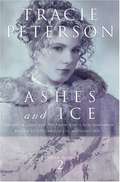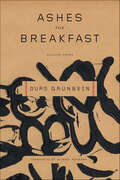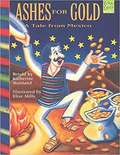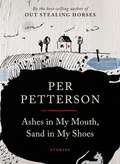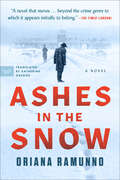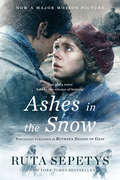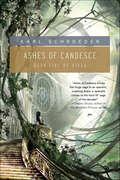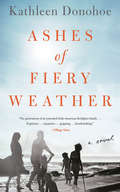- Table View
- List View
Ashes and Ice (Yukon Quest #2)
by Tracie PetersonThe search for home continues for the memorable characters introduced in Treasures of the North. God's promise of a new life has led them to Alaska, yet the trials of this fierce land cause them to question His leading. When tragedy strikes, the faith that has brought Karen so far from home begins to falter. Meanwhile, having been forced into marriage, Grace wonders if her love for Peter can withstand their differing beliefs. As adventure and romance merge, God's faithfulness is revealed.
Ashes and Stones: A Journey Through Scotland in Search of Women Hunted as Witches
by Allyson ShawA moving and personal journey, along rugged coasts and through remote villages and cities, in search of the traces of those accused of witchcraft in seventeenth-century Scotland.'It's summer. I stand where perhaps Ellen stood, in this ground thick with new thistle and long grass. She would have kenned this coast in all weathers: in the summer when it was as gentle as a lake and in the winter, with the high winds and stinging salt spray.' In Ashes and Stones we visit modern memorials and standing stones, and roam among forests and hedge mazes, folklore and political fantasies. From fairy hills to forgotten caves, we explore a spellbound landscape. Allyson Shaw untangles the myth of witchcraft and gives voice to those erased by it. Her elegant and lucid prose weaves together threads of history and feminist reclamation to create a vibrant memorial. This is the untold story of the witches' monuments of Scotland and the women's lives they mark. Ashes and Stones is a trove of folklore linking the lives of contemporary women to the horrors of the past, a record of resilience and a call to choose and remember our ancestors.
Ashes and Stones: A Scottish Journey in Search of Witches and Witness
by Allyson Shaw'It's summer. I stand where perhaps Ellen stood, in this ground thick with new thistle and long grass. She would have ken this coast in all weathers: in the summer when it was as gentle as a lake and in the winter, with the high winds and stinging salt spray.'A beautifully written journey through Scottish history and across the Scottish landscape in search of the women accused and killed during the witch hunts.Ashes and Stones is a moving and personal journey, along rugged coasts and through remote villages and modern cities, in search of the traces of those accused of witchcraft in seventeenth-century Scotland. We visit modern memorials, roadside shrines and standing stones, and roam among forests and hedge mazes, folk lore and political fantasies. From fairy hills to forgotten caves, we explore a spellbound landscape.Allyson Shaw untangles the myth of witchcraft and gives voice to those erased by it. Her elegant and lucid prose weaves threads of history and feminist reclamation, alongside beautiful travel, nature and memoir writing, to create a vibrant memorial. This is the untold story of the witches' monuments of Scotland and the women's lives they mark. Ashes and Stones is a trove of folklore linking the lives of modern women to the horrors of the past, and it is record of resilience and a call to choose and remember our ancestors.(P)2023 Hodder & Stoughton Limited
Ashes and Stones: A Scottish Journey in Search of Witches and Witness
by Allyson Shaw'Allyson Shaw has built a monument in words to the thousands persecuted as witches in Scotland. A fascinating and necessary book.' Peter Ross'It's summer. I stand where perhaps Ellen stood, in this ground thick with new thistle and long grass. She would have ken this coast in all weathers: in the summer when it was as gentle as a lake and in the winter, with the high winds and stinging salt spray.'A moving and personal journey, along rugged coasts and through remote villages and cities, in search of the traces of those accused of witchcraft in seventeenth-century Scotland.In Ashes and Stones we visit modern memorials and standing stones, and roam among forests and hedge mazes, folklore and political fantasies. From fairy hills to forgotten caves, we explore a spellbound landscape.Allyson Shaw untangles the myth of witchcraft and gives voice to those erased by it. Her elegant and lucid prose weaves together threads of history and feminist reclamation to create a vibrant memorial. This is the untold story of the witches' monuments of Scotland and the women's lives they mark. Ashes and Stones is a trove of folklore linking the lives of contemporary women to the horrors of the past, a record of resilience and a call to choose and remember our ancestors.'A compelling and intimate pilgrimage across Scotland' Helen Callaghan
Ashes for Breakfast: Selected Poems
by Durs GrünbeinThe first English translation of Germany's leading contemporary poet....what is the whole surreal jokeshopof terrors compared to theinfinitely chance littletricks of a poem.--from "MonoLogical Poem #1"Born in Dresden in 1962, Durs Grünbein is the most significant and successful poet to emerge from the former East Germany, a place where, he wrote, "the best refuge was a closed mouth." In unsettling, often funny, sometimes savage lines whose vivid images reflect his deep love for and connection with the visual arts, Grunbein is reinventing German poetry and taking on the most pressing moral concerns of his generation. Brilliantly edited and translated by the English poet Michael Hofmann, Ashes for Breakfast expertly introduces Germany's most highly acclaimed contemporary poet to American readers.
Ashes for Gold: A Tale From Mexico (Mondo Folktales)
by Katherine MaitlandTricked by a clever acquaintance, a poor Mexican still manages to turn ashes into gold.
Ashes for the Elephant God
by Vijaya SchartzTo scatter her brother's ashes over the Narmada River, Fabienne leaves France for the mysterious India of her childhood dreams. As she awakens to a newfound spirituality, unexpected visions of a former life during the Raj stir ancient yearnings for a long lost passion. Mukunda, the palace architect Fabienne loved a century and a half ago, lives again as an American engineer and works on the local dam project. As Fabienne falls in love again with India and the man of her destiny, the tapestry of her previous life unfolds. But, in the karmic land of the blue gods, a ruthless foe lies in wait. The Kali worshiper, who murdered the two lovers in a faraway past, has come back through the centuries to thwart their dream once more.
Ashes in My Mouth, Sand in My Shoes: Stories
by Per PettersonThe heartwarming debut that brought Per Petterson, the author of the highly acclaimed Out Stealing Horses, to prominenceYoung Arvid Jansen lives on the outskirts of Oslo. It's the early sixties; his father works in a shoe factory and his Danish mother works as a cleaner. Arvid has nightmares about crocodiles and still wets his bed at night, but slowly he begins to understand the world around him. Vivid images accompany each new event: A photo of his mother as a young woman makes him cry as he realizes how time passes, and the black car that comes to collect his father on the day Arvid's grandfather dies reminds him of the passing of his bullfinch. And then, one morning, his teacher tells his class to pray because a nuclear war is looming. Ashes in My Mouth, Sand in My Shoes, Per Petterson's debut, in which he introduces Arvid Jansen to the world, is a delicate portrait of childhood in all its complexity, wonder, and confusion that will delight fans of Out Stealing Horses and new readers alike.
Ashes in the Snow
by Oriana RamunnoHarperVia Paperback OriginalA spellbinding murder mystery with the plotting and characterization of Louise Penny or Agatha Christie set in Auschwitz at Christmas, 1943. Auschwitz, 1943. It’s snowing outside and Block 10 looks even bleaker than usual. Gioele Errera, a young Jewish boy imprisoned in the camp, finds the body of an SS officer.Detective Hugo Fischer is sent to investigate the unexplained death of the renowned Nazi. But Hugo is hiding a secret – he is suffering from a degenerative disease. The only way for him to survive is to give his support to the Reich and hide his condition.In Auschwitz, Hugo comes face to face not only with a complex murder, but with a truth – that of the Final Solution. And he is forced to decide what is most important to him – and who, if anyone, he should try to save…Inspired by the author’s family history, this wonderfully atmospheric page-turner, set during World War II, introduces a memorable hero—the flawed and fascinating Hugo Fischer.
Ashes in the Snow (Movie Tie-In)
by Ruta SepetysAn international bestseller, a #1 New York Times bestseller, and now a major motion picture! Ruta Sepetys's Between Shades of Gray is now the film Ashes in the Snow!This special movie tie-in edition features 16 pages of color movie stills starring Bel Powley and Jonah Hauer-King in never-before-seen footage and a behind-the-scenes look at the making of the movie, plus a brand-new letter from the author! "Few books are beautifully written, fewer still are important; this novel is both." --The Washington PostFifteen-year-old Lina is a Lithuanian girl living an ordinary life -- until Soviet officers invade her home and tear her family apart. Separated from her father and forced onto a crowded train, Lina, her mother, and her young brother make their way to a Siberian work camp, where they are forced to fight for their lives. Lina finds solace in her art, documenting these events by drawing. Risking everything, she imbeds clues in her drawings of their location and secretly passes them along, hoping her drawings will make their way to her father's prison camp. But will strength, love, and hope be enough for Lina and her family to survive?A moving and haunting novel perfect for readers of The Book Thief.Praise for Between Shades of Gray:"Superlative. A hefty emotional punch." --The New York Times Book Review"Heart-wrenching . . . an eye-opening reimagination of a very real tragedy written with grace and heart." --The Los Angeles Times"At once a suspenseful, drama-packed survival story, a romance, and an intricately researched work of historial fiction." --The Wall Street Journal* "Beautifully written and deeply felt . . . An important book that deserves the widest possible readership." --Booklist, starred reviewA New York Times Notable bookAn international bestsellerA Carnegie Medal nomineeA William C. Morris Award finalistA Golden Kite Award winnerA Best Children's Book of 2011 selection from The Wall Street Journal, PW, SLJ, Booklist,Kirkus, iTunes, Amazon, St. Louis Post Dispatch, and Columbus DispatchILA Notable Book for a Global Society Award winnerWinner of 10 international book prizes across France, Sweden, Belgium, Lithuania, and Canada 26 state award lists4 starred reviewsAnd more!
Ashes in the Wind
by Kathleen E. WoodiwissA woman burdened by war...A doctor torn between passion and duty...A sweeping tale of love in the face of dishonor from the incomparable storyteller--Kathleen Woodiwiss.Alaina MacGaren is forced to flee the devastation of her homeland in the guise of a young boy, only to find sanctuary in the arms of an enemy. Cole Latimer is a dashing Yankee surgeon who has served the Union faithfully, and his tender heart compels him to help a ragged, innocent "lad" in need--never suspecting the rags conceal a bewitching belle suspected of being a rebel spy.But Alaina's masquerade does not fool Cole for long. And the strength, courage, and breathtaking sensuality of this woman whom it would be treasonous to love sets duty and desire at war within him. Yet Destiny has joined them for good or ill--and they both must follow where their hearts would lead them, if they are to build a glorious new life together out of the ashes of the old.
Ashes of Angels: Ashes Of Angels The Ninja Vampire's Girl (Of Angels and Demons #4)
by Michele HaufAs a muse, Cassandra Stevens had been warned of the Fallen angel who’d one day come to impregnate her with a nephilim, an evil offspring. But no one could have foreseen that Samandriel—the raven-haired, silver-winged Fallen one—would sweep her off her feet. Against all good sense, Sam stirred her suppressed desires, yet for her own sake she dared not arouse his carnal ones. For Sam had been summoned to earth by a dark vampire lord. And more Fallen were on their way. Despite the dangers, Cassandra needed Sam by her side, for only together could they prevent the apocalypse that had been unleashed…Originally published in 2011
Ashes of Aries
by Martha C. LawrenceWhen Matthew Fielding, the four-year-old son of a San Diego telecommunications mogul, turns up missing, the psychic skills of P. I. Elizabeth Chase are requested. The stakes are raised soon after Elizabeth begins her investigation when a wildfire breaks out in Rancho Santa Fe, the secluded community where Matthew and his family-and Elizabeth's own parents-live. Aided and abetted by the Santa Ana winds, flames rage out of control, consuming thousands of acres and dozens of homes. Before the ashes can be cleared away, another fire blazes through everything in its path. Are the kidnapper and arsonist one and the same? Will Elizabeth be able to find the clues she needs in the dying embers around her? It's a race against time itself as man and nature combine to wreak destruction on Elizabeth's community and keep a little boy lost forever.
Ashes of Candesce: Book Five Of Virga (Virga #5)
by Karl SchroederA world of endless sky, with no land, no gravity: this is Virga. Beginning in the seminal science fiction novel Sun of Suns, the saga of this striking world has introduced us to the people of stubborn pride and resilience who have made Virga their home; but also, always lurking beyond the walls of the world, to the mysterious threat known only as Artificial Nature. In The Sunless Countries, history tutor Leal Hieronyma Maspeth became the first human in centuries to learn the true nature of this threat. Her reward was exile, but now, in Ashes of Candesce, Artificial Nature makes its final bid to destroy Virga, and it is up to Leal to unite the quarrelling clans of her world to fight the threat.Ashes of Candesce brings together all the heroes of the Virga series, and draws the diverse threads of the previous storylines together into one climactic conflict. Blending steampunk styling with a far-future setting and meditations on the posthuman condition, Ashes of Candesce mixes high adventure and cutting-edge ideas in a fitting climax to one of science fiction's most innovative series.
Ashes of Fiery Weather: A Novel
by Kathleen DonohoeThis &“stunning and intimate portrayal of four generations of New York City firefighters somehow manages to be part Alice McDermott, part Denis Leary&” (Irish America). One of Book Riot&’s 100 Must-Read New York City Novels Firefighters walk boldly into battle against the most capricious of elements. Their daughters, mothers, sisters, and wives walk through the world with another kind of strength and another kind of sorrow, and no one knows that better than the women of the Keegan-O&’Reilly clan. Ashes of Fiery Weather takes us from famine-era Ireland to New York City a decade after 9/11, illuminating the passionate loves and tragic losses of generations of women in a firefighting family—with &“characters that come so vividly to life one forgets one is reading a novel . . . Anyone Irish will face an uncanny recognition in these pages; everyone else will be enthralled meeting such captivating figures&” (Matthew Thomas, New York Times–bestselling author of We Are Not Ourselves).
Ashes of Gold (Wings of Ebony)
by J. ElleIn the heart-pounding conclusion to the Wings of Ebony duology, which #1 New York Times bestselling author Nicole Yoon calls &“bold, inventive, big-hearted and deeply perceptive,&” Rue makes her final stand to reclaim her people&’s stolen magic.Rue has no memory of how she ended up locked in a basement prison without her magic or her allies. But she&’s a girl from the East Row. And girls from the East Row don&’t give up. Girls from the East Row pick themselves back up when they fall. Girls from the East Row break themselves out. But reuniting with her friends is only half the battle. When she finds them again, Rue makes a vow: she will find a way to return the magic that the Chancellor has stolen from her father&’s people. Yet even on Yiyo Peak, Rue is a misfit—with half a foot back in Houston and half a heart that is human as well as god, she&’s not sure she&’s the right person to lead the fight to reclaim a glorious past. When a betrayal sends her into a tailspin, Rue must decide who to trust and how to be the leader that her people deserve…because if she doesn&’t, it isn&’t just Yiyo that will be destroyed—it will be Rue herself.
Ashes of Heaven: The Lame Deer Fight—May 7,1877 and the End of the Great Sioux War (The Plainsmen Series)
by Terry C. JohnstonAshes of HeavenTerry C. JohnstonThe U.S. Army's goal: to wipe out the remnants of scattered, starving people on the frontier's Northern Plain. But before Colonel Nelson A. Miles, the Bear Coat, launched his spring campaign into the heart of Indian country, the commander took one last stab at negotiations—and called on a Cheyenne woman and the famous half-breed pony scout named Johnny Bruguier. Together, they traveled to the valley of the upper Rosebud River to urge the Sioux to surrender. But a personal grudge exploded in the ranks of the U.S. Army. Now, as a man and a woman risk their lives for peace, the culmination of the great Sioux War is set in motion, and the Bear Coat takes on the last of the fierce Lakota warriors...
Ashes of Honor (October Daye #6)
by Seanan McGuireIt's been almost a year since October "Toby" Daye averted a war, gave up a county, and suffered personal losses that have left her wishing for a good day's sleep. She's tried to focus on her responsibilities--training Quentin, upholding her position as Sylvester's knight, and paying the bills--but she can't help feeling like her world is crumbling around her, and her increasingly reckless behavior is beginning to worry even her staunchest supporters. To make matters worse, Toby's just been asked to find another missing child ... only this time it's the changeling daughter of her fellow knight, Etienne, who didn't even know he was a father until the girl went missing. Her name is Chelsea. She's a teleporter, like her father. She's also the kind of changeling the old stories warn about, the ones with all the strength and none of the control. She's opening doors that were never meant to be opened, releasing dangers that were sealed away centuries before--and there's a good chance she could destroy Faerie if she isn't stopped. Now Toby must find Chelsea before time runs out, racing against an unknown deadline and through unknown worlds as she and her allies try to avert disaster. But danger is also stirring in the Court of Cats, and Tybalt may need Toby's help with the biggest challenge he's ever faced. Toby thought the last year was bad. She has no idea.
Ashes of Honor (October Daye #6)
by Seanan McGuireIt's been almost a year since October "Toby" Daye averted a war, gave up a county, and suffered personal losses that have left her wishing for a good day's sleep. She's tried to focus on her responsibilities -- training Quentin, upholding her position as Sylvester's knight, and paying the bills -- but she can't help feeling like her world is crumbling around her, and her increasingly reckless behavior is beginning to worry even her staunchest supporters. To make matters worse, Toby's just been asked to find another missing child. . . only this time it's the changeling daughter of her fellow knight, Etienne, who didn't even know he was a father until the girl went missing. Her name is Chelsea. She's a teleporter, like her father. She's also the kind of changeling the old stories warn about, the ones with all the strength and none of the control. She's opening doors that were never meant to be opened, releasing dangers that were sealed away centuries before -- and there's a good chance she could destroy Faerie if she isn't stopped. Now Toby must find Chelsea before time runs out, racing against an unknown deadline and through unknown worlds as she and her allies try to avert disaster. But danger is also stirring in the Court of Cats, and Tybalt may need Toby's help with the biggest challenge he's ever faced. Toby thought the last year was bad. She has no idea. "Toby's unusual heritage and her uneasy relationships with her mother's family will remind readers of Briggs' Mercy Thompson series, and Thompson fans will appreciate Toby's tough and self-reliant character. . . a must for fans of genre-bending blends of crime and fantasy. " -- Booklist (starred review)
Ashes of Honor (Toby Daye #6)
by Seanan McGuireThe sixth instalment of the highly praised Toby Daye series.It’s been almost a year since October ‘Toby’ Daye averted a war, gave up a county, and suffered personal losses that have left her wishing for a good day’s sleep. She’s tried to focus on her responsibilities, but she can’t help feeling like her world is crumbling around her – and her increasingly reckless behaviour is beginning to worry even her staunchest supporters.To make matters worse, Toby’s just been asked to find another missing child…only this time it’s the changeling daughter of her fellow knight, Etienne. Chelsea is the kind of changeling the old stories warn about: the ones with all the strength and none of the control. She’s opening doors that were never meant to be opened, releasing dangers that were sealed away centuries before – and there’s a good chance she could destroy Faerie if she isn’t stopped. Now Toby must find Chelsea before time runs out, racing against an unknown deadline and through unknown worlds as she and her allies try to avert disaster.Toby thought the last year was bad. She has no idea.
Ashes of Man (Sun Eater #5)
by Christopher RuocchioThe fifth novel of the galaxy-spanning Sun Eater series merges the best of space opera and epic fantasy, as Hadrian Marlowe continues down a path that can only end in fire.The galaxy is burning. With the Cielcin united under one banner, the Sollan Empire stands alone after the betrayal of the Commonwealth. The Prophet-King of the Cielcin has sent its armies to burn the worlds of men, and worse, there are rumors...whispers that Hadrian Marlowe is dead, killed in the fighting. But it is not so. Hadrian survived with the help of the witch, Valka, and together they escaped the net of the enemy having learned a terrible truth: the gods that the Cielcin worship are real and will not rest until the universe is dark and cold. What is more, the Emperor himself is in danger. The Prophet-King has learned to track his movements as he travels along the borders of Imperial space. Now the Cielcin legions are closing in, their swords poised to strike off the head of all mankind.
Ashes of Midnight (Midnight Breed #6)
by Lara AdrianA woman driven by blood. A man thirsting for vengeance...As night falls, Claire Roth flees, driven from her home by a fiery threat that seems to come from hell itself. Then, from out the flames and ash, a vampire warrior emerges. He is Andreas Reichen, her one-time lover but now a stranger consumed by vengeance. Caught in the crossfire, Claire cannot escape his savage fury - or the hunger that plunges her into his world of eternal darkness and unending pleasure.Nothing will stop Andreas from destroying the vampire responsible for slaughtering his Breed brethren... even if he must use his former lover as a pawn in his deadly mission. Claire can lead Andreas to the enemy he seeks but it is a journey fraught with danger - and deep desire. For Claire is the one woman Andreas should not crave, and the only one he's ever loved. So a dangerous seduction begins - one which blurs the line between predator and prey, love and hate...
Ashes of Midnight (Midnight Breed Series, #6)
by Lara AdrianBONUS: This edition contains an excerpt from Lara Adrian's Shades of Midnight.A woman driven by blood. A man thirsting for vengeance. A place where darkness and desire meet... As night falls, Claire Roth flees, driven from her home by a fiery threat that seems to come from hell itself. Then, from out of the flames and ash, a vampire warrior emerges. He is Andreas Reichen, her onetime lover, now a stranger consumed by vengeance. Caught in the cross fire, Claire cannot escape his savage fury--or the hunger that plunges her into his world of eternal darkness and unending pleasure. Nothing will stop Andreas from destroying the vampire responsible for slaughtering his Breed brethren . . . even if he must use his former lover as a pawn in his deadly mission. Blood-bonded to his treacherous adversary, Claire can lead Andreas to the enemy he seeks, but it is a journey fraught with danger--and deep, unbidden desires. For Claire is the one woman Andreas should not crave, and the only one he's ever loved. A dangerous seduction begins--one that blurs the lines between predator and prey, and stokes the flames of a white-hot passion that may consume all in its path. . . .
Ashes of Roses
by M. J. AuchWhen Rose Nolan arrives on Ellis Island as a seventeen-year-old Irish immigrant, she is looking for a land of opportunities; what she finds is far from all she'd dreamed. Stubborn and tenacious, she refuses to give up. Left alone to fend for herself and her younger sister, Rose is thrust into a hard-knock life of tenements and factory work. <p><p>But even as she struggles, Rose finds small bright points in her new life―at the movies with her working friends and in the honest goals of her mentor, Gussie. Still, after her exhausting days as a working girl, Rose must face the confusion of balancing her need for simple fun with her more wary feelings about joining Gussie in her fight for better working conditions. <p><p>When the devastating Triangle Shirtwaist Factory Fire of 1911 rushes into Rose's life, her confusions are brought to an all-too-painful head. To whom and to what can she turn when everything around her is in ashes? <p><p>Sharp, poignant, and stirringly real, MJ Auch has written a powerful historical novel that is hard to put down.
Ashes of Roses
by MJ AuchThe honest and compelling story of a young girl's newfound independence, from her entrance into a new country to her frightening involvement in the Triangle Shirtwaist Factory Fire of 1911.My heart filled with fear and hope at the same time. I had the feeling that I was brought to America for a purpose. Something important would happen to me here.I remembered the words of the poem, "Give me your tired, your poor, your huddled masses . . .""Here we are, America," I whispered. "We're just exactly what you ordered."When she arrives on Ellis Island as a seventeen-year-old Irish immigrant, Rose Nolan is looking for a land of opportunities; what she finds is far from all she'd dreamed. Stubborn and tenacious, she refuses to give up. Left alone to fend for herself and her younger sister, Rose is thrust into a hard-knock life of tenements and factory work.When the devastating Triangle Shirtwaist Factory Fire of 1911 rushes into Rose's life, her confusions are brought to an all-too-painful head. To whom and to what can she turn when everything around her is in ashes?
